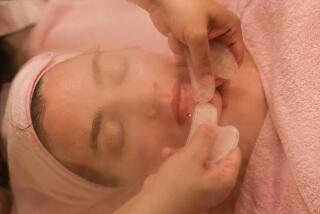Plastic surgeons find customers are seeking lower-cost treatments
In the fall season opener of “Nip/Tuck,” the sleek Los Angeles office of McNamara/Troy sat forlorn and empty, a voice-over reminding that when times are tough, one of the first things to go is the luxury of elective cosmetic surgery.
That same scene could be played out in plastic surgeons’ offices all over, as people seem to be passing up big-ticket beauty procedures -- face-lifts, liposuction, breast augmentation -- and seeking less expensive ways to achieve beauty ideals.
According to both the American Society of Plastic Surgeons and the American Society for Aesthetic Plastic Surgery, the number of cosmetic surgical procedures done in 2008 was lower than in 2007 -- by 9%, according to the ASPS, and 15%, according to the ASAPS. And although 2009 figures will not be available until late February or early March, plastic surgeons say, anecdotally, that business for the year was down at least 20% from 2008.
As a result, cosmetic surgery practices are finding themselves acting somewhat as financial consultants to their patients, helping them work out payment plans, negotiating fees and making out lists of priorities -- a Brazilian butt lift can wait, but those wrinkles under the eyes need to be dealt with right away. In addition, plastic surgeons who previously only focused on the expensive and invasive procedures have had to turn their hands to the quick fixes -- fillers, peels, laser treatments -- which are increasingly in demand now.
“We thought we’d be insulated better,” said Dr. Toby Mayer, a Beverly Hills cosmetic surgeon. “But even though we have a large percentage base of Hollywood clients who are not affected by these economic conditions, for the large majority of our patients, the big procedures are out of the question for now.”
Nonetheless, and partly because of an increasingly competitive job market, people still want to get work done, Mayer said, but they need cheaper options. Among them: Botox, Restylane and other injectibles that minimize wrinkles are proving especially popular and, at about $1,000 a treatment, are more affordable than the average $10,000 for a face-lift.
It’s not just cosmetic surgeons who are having to play to the demands of the market. Dermatologists, hairstylists and all manner of beauty professionals are having to tailor their businesses to a marketplace now focused much more on the bottom line. In effect, luxurious and indulgent treatments are out; quick fixes with immediate results are in.
“Two years ago, it wasn’t unusual for a patient to request a laser treatment, Botox and Restylane all on the same visit,” said Dr. Jessica Wu, a Westwood dermatologist. “Nowadays, they’re more likely to ask me which treatment they should do first, and which ones can wait till the next visit . . . so that we can prioritize what treatments we should do first.”
Despite L.A.’s reputation as a body-conscious town, beauty practitioners say patients and clients are forgoing work on their bodies and concentrating primarily on the face. With the job market skewing younger, beauty professionals say, people come in saying they need to look more youthful, and quickly.
“If I look at my practice now compared to 15 years ago, the motivations are different,” said Dr. Brent Moelleken, a plastic surgeon who has practices in Beverly Hills, Santa Barbara and Bakersfield. “Before, women would come in after they got divorced or widowed. Today, it’s seen almost as a necessity to remain competitive in the business world. But while they’re still concerned about a pot belly or their breasts, they are much more economically minded. They don’t just walk into a plastic surgeon’s office and get the most expensive procedure: They shop around, go to many doctors, look at prices and negotiate. In the heyday, even five years ago, they would be embarrassed to negotiate. Today, it’s the rule.”
Experts are seeing trends across the board that are providing an insight into how people are choosing to spend their beauty dollars: Injectibles are holding their own, expensive products are not. The time between haircuts and mani/pedis is being stretched out, and massages and other body treatments are being postponed. But while fewer people are signing up for pricey liposuction surgeries, treatments such as laser liposculpture are proving popular.
“The economy has not really impacted us,” said Dr. Anh Ngo, medical director of Final Inches, a facility that offers laser liposculpture at its three L.A.-area branches. “We have a four- to six-week waiting list.” The treatment is a cheaper and less invasive form of liposuction. It costs about $3,000 per area, about half of what liposuction costs, with almost no downtime for the patient.
“We’re a better deal for the same results,” said Ngo. “We see patients who have thought about it for years. Even if they haven’t saved up for it, they seem to see the value in it for them. They want to see the quick results, so they can look and feel good on those job interviews.”
Dr. John Kahen, a hair transplant surgeon in Beverly Hills, is seeing something similar in his field.
“If our patients don’t have the financial capability of doing a transplant procedure, there are alternative methods that are much cheaper,” he said. Among them: the HairMax Laser Comb, an FDA-approved, at-home appliance to help stave off thinning hair. At $495, it is a lot cheaper than the $12,000 to $16,000 for transplant surgery.
“Patients are bargaining for the best available price and the best available therapy,” Kahen said. He is responding to the market by offering financing as well as money-back guarantees. “People want to try the cheaper alternatives first. If they don’t work, they come back and get the more expensive thing done.”
Tracey Sameyah, president of the Murad Inclusive Health Spa in El Segundo, said that visits for treatments that are “less publicly visible -- like body treatments and wet therapies”-- are being put off.
“Clients want serious skin-care solutions, not a vague, generalized promise of beauty,” she said. “Demand for Botox and fillers remains steady, but we’ve actually seen a boost in demand for our Techno Skin Resurfacing Treatment, which combines microdermabrasion with a chemical peel. It’s part of a trend we’re seeing of clients wanting to evaluate the full range of options for dramatic improvement in their appearance without the expense and risk of surgery.”
Beauty aficionados say that the economy has provided a lesson in prioritizing their beauty budgets. Connie Bang, who was laid off in 2009 and is now a freelance commercial producer, said her weekly mani/pedis, massages and body scrubs have fallen by the wayside.
“There were all these extraneous, exorbitant things,” she said. “I’m in reset mode. I had to set my priorities.” So she’s put off nail treatments until, as she puts it, “my nails start curling over” and has facials once every other month. She continues to buy Dr. Harold Lancer skin-care products, which retail for $30 to $125, but said she uses them sparingly. Everything else, she said, has to wait.
“If I had a spot here or there, I would go in for a laser or power peel treatment without hesitation,” she said. “But I’ve had to cut the fat. I used to put the Lancer products everywhere, just luxuriate in it. But now I just use it in smaller quantities on my face. Other parts of my body get the stuff from Rite-Aid.”
Doctors and beauty experts say they are having to find ways to be inventive and to tap into what people need in this new climate. Dermatologist Wu is making more house calls “because people are more careful about obvious spending.”
“Even if they can afford it, when their friends and family are being downsized, they may not want to be seen coming out of a dermatologist’s office,” she said.
At the Veronica Skin & Body Care Center in Malibu, owner Veronica Barton-Schwartz is offering $55 mini-facials combined with a $20 power yoga class so clients feel like they’re still getting a beauty fix but at streamlined prices. She has also recently launched a four-step “facial in a bag,” which costs $88 but will provide about 16 facials at home.
Dr. Debra Luftman, a dermatologist, helps patients prioritize their beauty spending by advocating simple drugstore brands in favor of expensive creams and suggesting fillers like Juvederm, which, at $500 to $700 a syringe, can replicate the effects of a face-lift for about a year.
“We all want immediate gratification -- more so now, when times are distressing,” she said. “I like to make a plan with my patients, look at treatments over a period of time and budget everything. We’re doing incentives and packages to make it easier for them. They don’t even have to ask me.”


